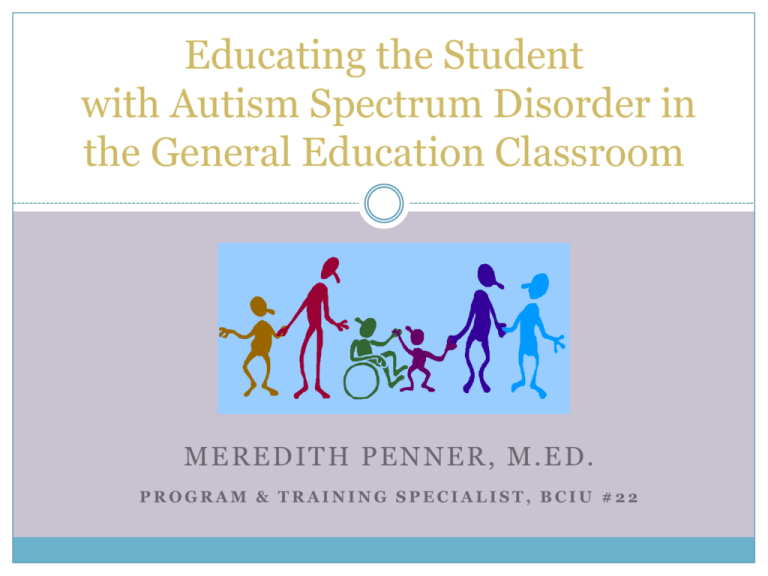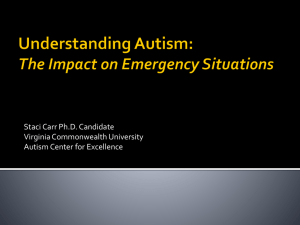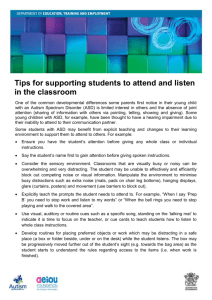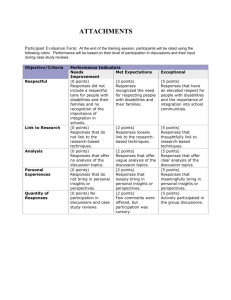Educating Students with Autism in the General Education Classroom
advertisement

Educating the Student with Autism Spectrum Disorder in the General Education Classroom M E R E D IT H P E N N E R, M .E D . PROGRAM & TRAINING SPECIALIST, BCIU #22 Gaskins Overview Formal resolution between the Pennsylvania Department of Education (PDE) and a group of families and advocacy organizations who had filed a class-action lawsuit against PDE on behalf of a group of children with disabilities in 1994. Gaskins… Goal is to ensure that the IEP team first considers the regular classroom with supplementary aids and services before considering a more restrictive environment Increase opportunities for students with disabilities to receive the supports and services needed to be educated with nondisabled peers in regular classrooms in their home schools General Education General Education with accommodations & modifications General Education with modifications & adaptations General Education with focus on IEP goals NOT grade level curriculum (collaboration with special education teacher) General Education with 1 on 1 supports % of day spent in alternate setting (smallest amount possible) Separate setting for majority of day within public school APS Approximate State Targets (2010) % of special education students placed in: General Ed >80% General Ed 40-79% General Ed < 40 Alternate Placements 65% 24% 8.7% 3.3% 100 schools were identified over the last 5 years in PA for improvement plans in these various categories as a result of the Gaskins Settlement Least Restrictive Environment Child must be educated in the general education setting to the greatest extent possible considering all of the possible supplemental aids and services Inclusion does not mean that the student’s progress must be measured by mastery of general education curriculum, but could be measured by progress made toward IEP goals and objectives The levels of supports and accommodations needed are to provide students the opportunity to participate with their non-disabled peers in a general education setting NOT to be used as a basis for placing them in an alternate (more restrictive) setting Burns,Edward. (2003) A Handbook for Supplementary Aids and Services. Springfield Ill: Charles C. Thomas Supplemental Aids and Services Collaborative Adults working together to support students Instructional development and delivery of instruction that addresses diverse learning needs Physical adaptations and modifications to the physical environment Social-Behavioral supports and services to increase appropriate behavior and reduce disruptive or interfering behavior DSM-IV General Deficit Areas of ASD Communication Social skills Restricted interests Sensory integration Behavior Additional Core Deficits Difficulty identifying important global concepts and elements of tasks Difficulty with processing auditory information-understanding, retaining and retrieving Difficulty generalizing skills-skills must be taught in context Difficulty with sequencing information or steps in a task Difficulty with transitioning Difficulty with time concepts and time management Uneven academic, social, or emotional development (high functioning in some areas, low in others What specifically is ASD??? Classic Autism usually non-verbal, unengaged, and unable to perform well on standard diagnostic tests. Affects communication, social skills, and verbal/nonverbal play Sometimes paired with Intellectual Disabilities High Functioning Autism use meaningful language, read, write, do math, show affection, complete daily tasks but can't hold eye contact, maintain a conversation, engage in play, pick up on social cues PDD-NOS “catch all” all function levels whose symptoms don't fully correlate with classic autism Asperger’s Syndrome Affects the same triad of impairments as autism Usually average to above average intelligence Diagnosed around or after age 3 Characteristics of Asperger’s Syndrome Engaging in one-sided, long-winded conversations, without noticing if the listener is listening or trying to change the subject Displaying unusual nonverbal communication, such as lack of eye contact, few facial expressions, or awkward body postures and gestures Showing an intense obsession with one or two specific, narrow subjects, such as baseball statistics, train schedules, weather or snakes Appearing not to understand, empathize with or be sensitive to others' feelings Having a hard time "reading" other people or understanding humor Speaking in a voice that is monotonous, rigid or unusually fast Moving clumsily, with poor coordination http://www.mayoclinic.com/ Why do educators need to know about ASD? U.S. FACTS: A new case of autism is diagnosed nearly every 20 minutes There are 24,000 new cases diagnosed in the U.S. each year The economic impact of autism is more than $90 billion and is expected to more than double in the next decade. Autism receives less than 5% of the research funding of many less prevalent childhood diseases. There is no medical detection or cure for autism. http://www.talkaboutcuringautism.org/autism/latest_autism_statistics.htm How does ASD affect learning and behavior? Affects the neurodevelopment, resulting in distinct learning and behavioral styles Underlying biological/genetic cause that produces organic and/or physical changes during brain development-resulting in atypical cognitive and social development Affects individuals uniquely Affects the ability to integrate sensory information and regulate emotions Role of General Educators in the IEP Provide information about how the included student performs academically and socially in the general education setting Identify types and amounts of support students may need in their classroom (SaS) Develop accommodations and modifications to allow students to access the general education curriculum Regular education classroom teachers are an integral member of the IEP team for the included student Sample Planning Template: Activity/ lesson Goal/ Objective of target student Accommodations & Modifications Prompting level Assessment Tool Interventions and Strategies for Students with ASD No single intervention or strategy has proven to be successful for all students with ASD To maximize the effect of the intervention, consider the student’s following: Communication proficiency Preferred mode of communication Cognitive ability Learning style Interests and motivators Interventions and Strategies for Students with ASD Students with ASD require direct instruction in all areas due to the difficulty with generalization Interventions/strategies must be connected to and generalized across settings, partners, materials, etc. Use of video modeling helps students with ASD to see first hand examples of target behaviors in authentic environments Strategies to Facilitate Successful Inclusion Consistent classroom routines Provide visual schedules, rules, choice boards and instructions (either pictures or words) Social Stories http://www.polyxo.com/socialstories/ Be aware of situations causing anxiety and stress-use pre-teaching, priming, and sensory breaks to reduce anxiety Strategies… Plan for transition or changes in schedule-transition cue, schedule changes written in different color, discuss changes with student prior to event happening if possible Be cognizant of specially-designed instruction as per IEP-preferential seating, peer buddy, writing accommodations, etc. (Goals at a Glance or Meet ____) Highlight directions or tasks, number steps, provide an example Simplify directions More strategies Make sure purpose of activity is clearly explained…students with ASD have difficulty making inferences Use subjects or items of interest to increase motivation and participation Use scripts and model expectations for group work Color coding subject areas…folders and notebooks for organization Communication Concerns Difficulty with answering “wh” questions Difficulty with understanding figurative language, persuasive techniques, idioms, words with multiple meanings Difficulty finding most important details or information-stories and text Strategies for Improving Communication Skills Pre-teach new concepts and content vocabulary prior to group instruction using visual cues Model procedures, expectations, thinking strategies, or directions Post visual reminders for components of essential concepts or questions (posting subject goals, objectives, content vocabulary) Communication Strategies Pair verbal instructions with visual cues Identify verbally and visually when transitions occur Use auditory signals to alert students of important information, repeat information Provide handouts for information being taught orally (key words, open notes) Communication Strategies Be careful of comments or information you say around students with ASD, they may copy it or repeat it out of context Try to avoid assessments that rely heavily on essay or short answer questions (fill in the blank or multiple choice are better) Allow students to dictate open ended responses to reading assignments if there is a processing or writing deficit that could impact their reading assessment (also an allowable accommodation on the PSSA) More Communication Strategies Provide communication supports to help with student independence in initiating conversations (choice cards for asking for help) Encourage conversations, pull more language, don’t except one word answers If you know about an event a student participated in ask the student about it, try to engage student in a conversation about it Sensory Integration Issues Sensory integration refers to the manner in which the brain processes, organizes and interprets information coming from the sensory system Students with ASD have a variety of sensory impairments Difficulty with gross and fine motor movements, locating their bodies in space, and regulating the level of sensory input Sensory Difficulties Students with ASD may have difficulty with sensory processing in the following areas: -Sensitivity/insensitivity to sensory information -Attention and focus -Regulation of activity level -Transitions to between activities -Control of impulses, behaviors, and/or fear in dangerous situations -Oral Motor (objects in mouth, etc) -Recognition of personal space Sensory Accommodations to Promote Focus Locate student desk in an area that will allow the students to adjust to changes Clearly defined areas within the classroom (work, leisure, break, prohibited areas) Seat cushions Provide opportunities for movement (songs, exercises during transitions) Suggest a sensory break (walk, deliver note or books to other teacher) Sensory Accommodations: Writing Allow student to type assignments (Alpha Smart) Use graph paper to organize math problems and lined paper for writing tasks Pencil grips Mechanical pencils (students who press too hard) Markers (students who press too lightly) More Writing Accommodations Use slant board Remind students to hold paper with non dominant hand Shortened writing assignments, multiple choice options, fill in the blank, provide answers orally Peer note taker Accommodations for Sensory Sensitivities Menu or choice card for sensory breaks/stress release activities (leave noise environment, etc) Have “obsessive”/stress release items in a designated place. Provide clears instructions of when, where and how items can be used Approach student from front if possible Have student use headphones in loud/over stimulating situations Students with sensory difficulties should not be denied breaks, recess or P.E class Socialization/Social Skills Students with ASD may exhibit deficits in some or all of the following: Engaging in reciprocal interactions Maintaining eye contact Attention to gestures or facial expressions Conforming to rules of social behavior Engaging in conversations on nonpreferred topics Social Skill Deficits: Transitioning between conversation topics Feeling empathy Engaging others appropriately in social situations Initiating, terminating, and repairing conversations Understanding importance of small talk and other social speech Strategies to Improve Social Skills Provide explicit instruction and reminders of conversation etiquette Teach students to recognize facial features/emotions in others Practice newly learned skills in various settings Practice a menu of relaxation strategies and/or establish code words to use when they are upset Card system for high stress time Stress thermometer Strategies to Improve Social Skills, cont. Social stories Practice transitions Teach acceptance of student differences Increase student engagement with visual cues Behavioral Issues Students with ASD may exhibit immature or developmentally inappropriate behaviors Outbursts may result from frustration, anxiety, communication frustration, social interactions Strategies for Minimizing Inappropriate Behaviors Ritualistic and Compulsive Intervene early before behavior turns into a habit Teach when the behavior may occur Teach replacement behavior Strategies for Minimizing Inappropriate Behaviors Impulsivity Manage the environment to minimize impulsive behaviors Social stories Rehearse appropriate behaviors Strategies for Minimizing Inappropriate Behaviors Stereotypic Develop a sensory diet Develop a menu of appropriate sensory interventions to aid with sensory regulation Squeezing a koosh ball, swinging, asking for a break, computer time, weighted belt Strategies for Minimizing Inappropriate Behaviors Aggression Remove or minimize environmental stressors that trigger behaviors Clearly define all components of a task Provide clear directions Be aware of any possible aggressive behaviors via individual behavior plans as designed by the classroom teacher-follow plans as directed If a behavior is escalating to a form of physical aggression, notify the teacher immediately Do not intervene or try to deal with behavior if child is in physical danger or others are in danger Strategies for Minimizing Inappropriate Behaviors Inappropriate social interactions Rehearse appropriate social interactions Reward appropriate behaviors Use social stories Restricted Interests These subjects dominate their concentration and contribute to their inability to transition and their inflexibility Stereotypical behaviors may include Repeated hand and body movements Atypical response pattern to stimuli Difficulties with attention Obsession with certain objects or parts of objects Watching environmental stimuli such as lights, sounds, etc. Strategies for Accommodating Restrictive Interests Allow breaks to pursue their own interests-strict time limit Introduce new activities related to interest Teaching and Promoting Disability Awareness Model it yourself Use person first language Give age appropriate examples of ways we are all the same and different If necessary to talk about a specific student, do so ONLY with parent permission Allow students to talk about their own challenges (with parent permission) Use nationally recognized months to springboard activities (March- Disability awareness, April- Autism Awareness, http://www.ctserc.org/library/bibfiles/childlitdisab.pdf References (2005).http://www.pde.state.pa.us/special_edu/lib/special_edu/Settlement_Agreement -FINAL_%28no_draft%29.pdf. Retrieved October 21, 2007, from Pennsylvania Department of Education Web site: http://www.pde.state.pa.us/ View the entire Settlement Agreement at: www.pde.state.pa.us/special_edu/lib/special_edu/Settlement_Agreement.pdf. National Education Association, (2006).The Puzzle of Autism. 1, 1-33. http://www.talkaboutcuringautism.org/autism/latest_autism_statistics.htm http://www.mayoclinic.com/






